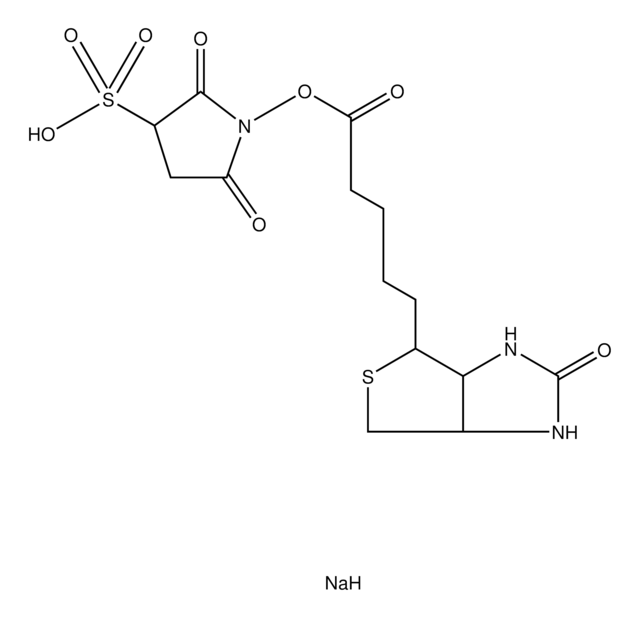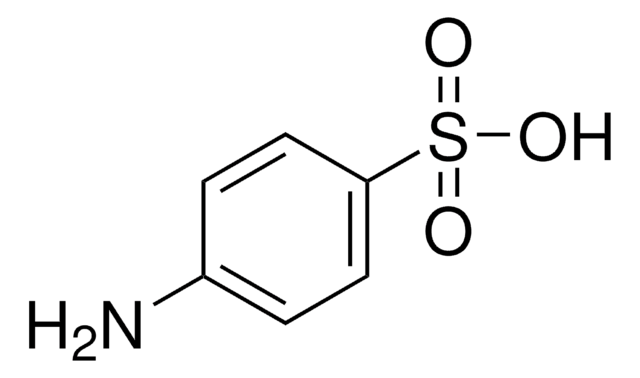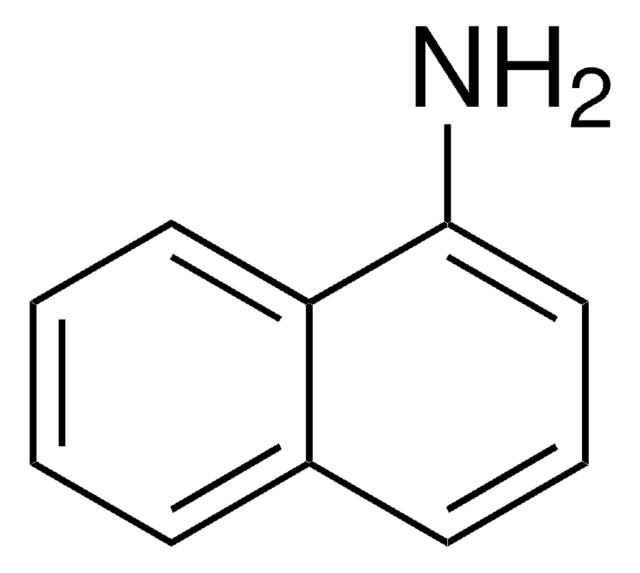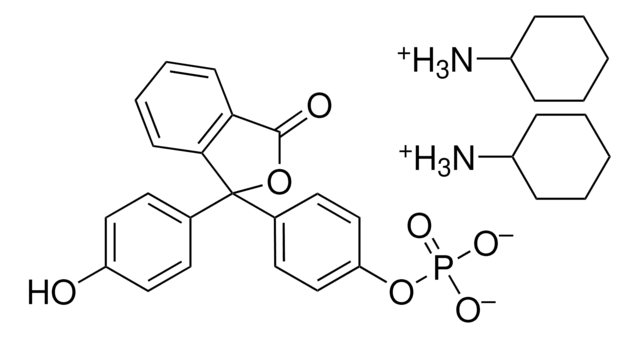B1022
Biotinamidohexanoic acid 3-sulfo-N-hydroxysuccinimide ester sodium salt
≥90% (TLC), powder
동의어(들):
Sulfosuccinimidyl 6-(biotinamido)hexanoate
로그인조직 및 계약 가격 보기
크기 선택
모든 사진(2)
크기 선택
보기 변경
About This Item
실험식(Hill 표기법):
C20H29N4NaO9S2
CAS Number:
Molecular Weight:
556.59
MDL number:
UNSPSC 코드:
12352203
PubChem Substance ID:
NACRES:
NA.46
추천 제품
Quality Level
분석
≥90% (TLC)
양식
powder
solubility
H2O: 10 mg/mL
DMF: 50 mg/mL
저장 온도
−20°C
SMILES string
[Na].OS(=O)(=O)C1CC(=O)N(OC(=O)CCCCCNC(=O)CCCCC2SCC3NC(=O)NC23)C1=O
InChI
1S/C20H30N4O9S2.Na.H/c25-15(7-4-3-6-13-18-12(11-34-13)22-20(29)23-18)21-9-5-1-2-8-17(27)33-24-16(26)10-14(19(24)28)35(30,31)32;;/h12-14,18H,1-11H2,(H,21,25)(H2,22,23,29)(H,30,31,32);;
InChI key
KDRVGWAQYRWAJF-UHFFFAOYSA-N
유사한 제품을 찾으십니까? 방문 제품 비교 안내
일반 설명
Biotinamidohexanoic acid 3-sulfo-N-hydroxysuccinimide ester sodium salt is a water soluble biotinylation reagent. It can be used in immunoprecipitation of signaling proteins. It can also be used in analysis of hyaluronan synthesis. Further, the product can also be used in ELISA. This biotinylation reagent has shown specificity for human dermal fibroblasts.
애플리케이션
Water soluble biotinylation reagent incorporating an aminocaproyl spacer. This can reduce the steric hindrance in binding avidin to some biotinylated compounds. Has also been used as a cell surface labeling reagent. Typically coupled to primary amine in the pH range 6.5-8.5. May be used for the biotinylation of cell surface proteins.
면책조항
Unless otherwise stated in our catalog or other company documentation accompanying the product(s), our products are intended for research use only and are not to be used for any other purpose, which includes but is not limited to, unauthorized commercial uses, in vitro diagnostic uses, ex vivo or in vivo therapeutic uses or any type of consumption or application to humans or animals.
신호어
Danger
유해 및 위험 성명서
Hazard Classifications
Repr. 1B
Storage Class Code
6.1C - Combustible acute toxic Cat.3 / toxic compounds or compounds which causing chronic effects
WGK
WGK 3
Flash Point (°F)
Not applicable
Flash Point (°C)
Not applicable
가장 최신 버전 중 하나를 선택하세요:
시험 성적서(COA)
Lot/Batch Number
이미 열람한 고객
S Schäfer-Somi et al.
Reproduction in domestic animals = Zuchthygiene, 41(1), 48-54 (2006-01-20)
Sera of healthy pregnant (group I, n = 11) and non-pregnant (group II, n = 11) bitches were screened for autoantibodies (AAb). In both groups, blood samples were drawn every fifth day between days 5 and 55 after mating. Serum
A V Vener et al.
Analytical biochemistry, 191(1), 65-69 (1990-11-15)
A colorimetric procedure to detect biotin bound to microtiter plates with a sensitivity down to 10(-16) mol was developed using biotinylated inorganic pyrophosphatase of Escherichia coli. Reaction of pyrophosphatase with 1 mM N-biotinyl-6-aminocaproic acid N-hydroxy-sulfonosuccinimide ester yielded a stable 87%
Improved nonradioactive cell surface labeling technique for immunoprecipitation.
L M Lantz et al.
BioTechniques, 18(1), 56-56 (1995-01-01)
Mohammed M Nooh et al.
American journal of physiology. Renal physiology, 317(2), F375-F387 (2019-05-30)
Arginine-vasopressin (AVP)-mediated translocation of aquaporin-2 (AQP2) protein-forming water channels from storage vesicles to the membrane of renal collecting ducts is critical for the renal conservation of water. The type-1 PDZ-binding motif (PBM) in AQP2, "GTKA," is a critical barcode for
Lingli Li et al.
The Journal of biological chemistry, 281(36), 26512-26519 (2006-07-01)
The extracellular matrix molecule hyaluronan was found to suppress platelet-derived growth factor (PDGF) beta-receptor activation and PDGF-BB-induced migration of primary human dermal fibroblasts. The suppressive effect of hyaluronan was neutralized by a monoclonal antibody that specifically inhibits hyaluronan binding to
자사의 과학자팀은 생명 과학, 재료 과학, 화학 합성, 크로마토그래피, 분석 및 기타 많은 영역을 포함한 모든 과학 분야에 경험이 있습니다..
고객지원팀으로 연락바랍니다.










